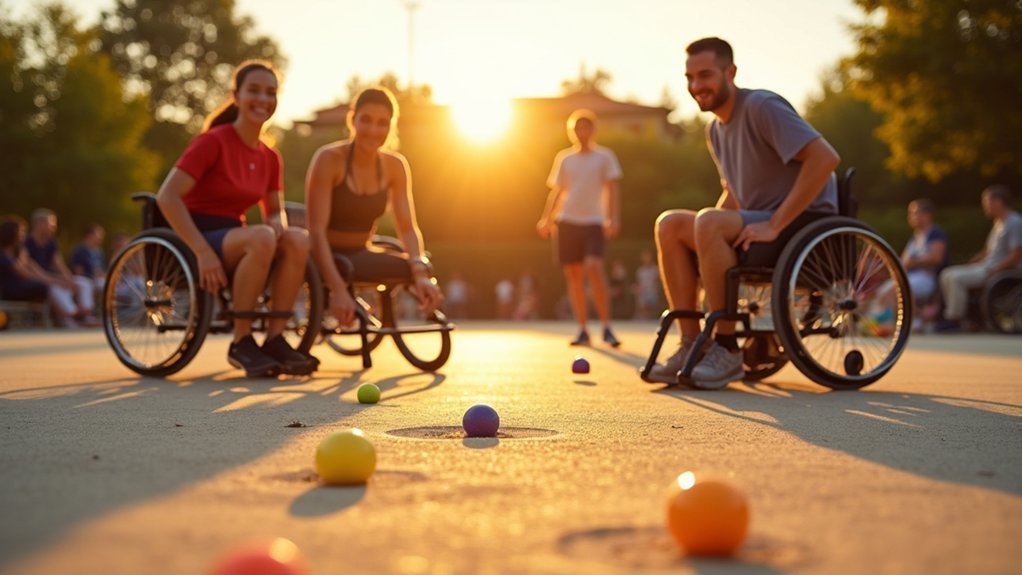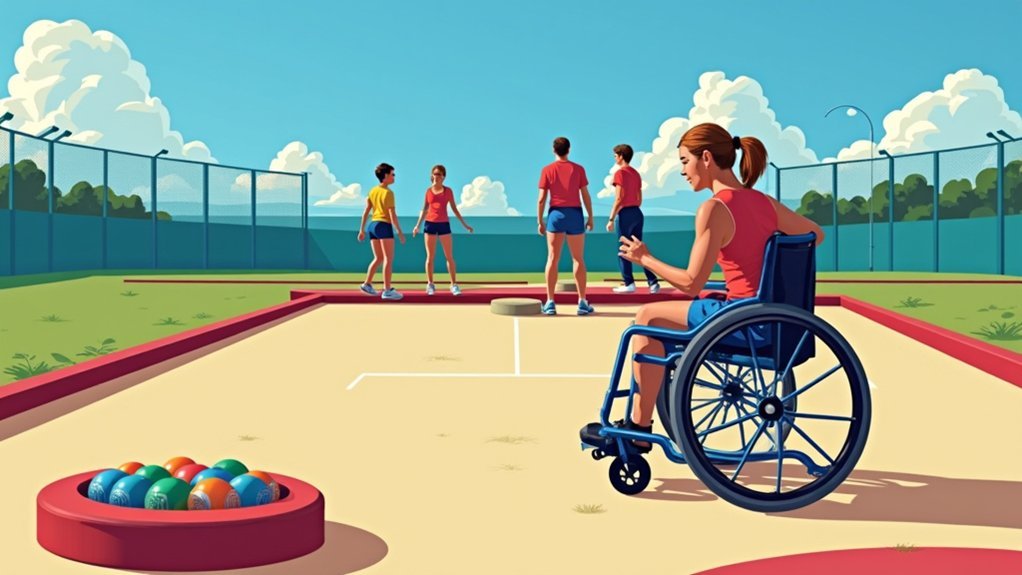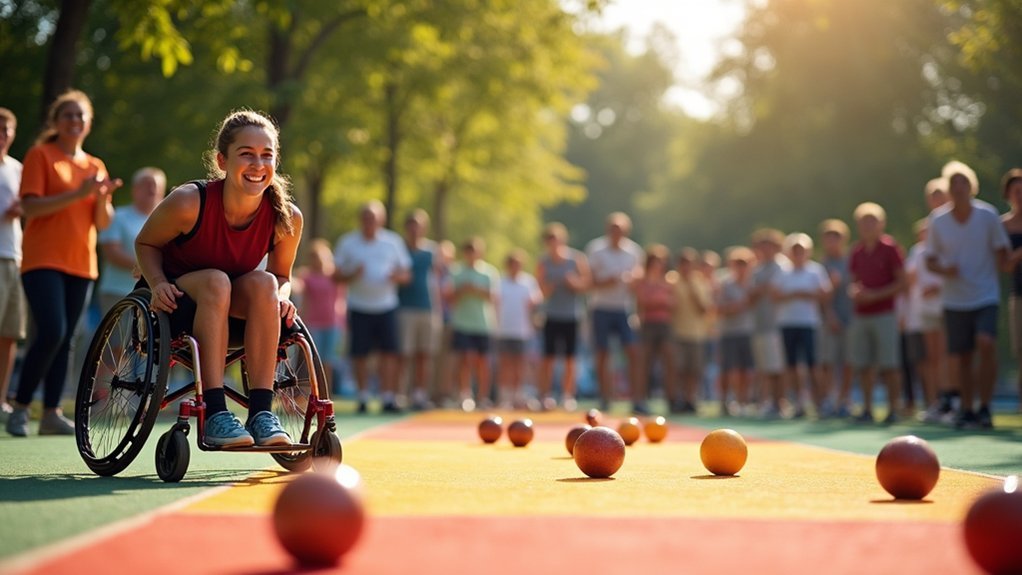Boccia, not traditional bocce, offers wheelchair accessibility through key adaptations. You’ll find wheelchair-friendly flat courts, specialized leather balls with minimal bounce, and the option to roll, kick, or throw from a seated position. Assistive devices like ramps and pointers help players with limited mobility compete effectively. A four-tier classification system (BC1-BC4) guarantees fair competition based on ability levels. Discover how these modifications create an inclusive sport that builds strength, coordination, and community connections.
Understanding Bocce vs. Boccia: Adaptations for Wheelchair Athletes

While traditional bocce requires players to stand when throwing balls, boccia offers a completely accessible alternative designed specifically for wheelchair athletes. Unlike its conventional counterpart, boccia allows players to roll, kick, or throw balls from a seated position, making it ideal for wheelchair users with physical disabilities.
The sport incorporates specialized adaptations including assistive devices such as ramps and pointers that help athletes deliver their shots with precision. The playing area is wheelchair-friendly—unwalled and sized similarly to a badminton court, facilitating easy navigation for participants.
To guarantee equitable competition, boccia categorizes athletes into four classes (BC1-BC4) based on their impairment levels. These thoughtful modifications allow wheelchair athletes to compete effectively while remaining seated throughout matches, even accommodating unintentional wheelchair movement during play.
Court Design and Accessibility Features for Wheelchair Mobility
The design of boccia courts represents a thoughtful integration of accessibility principles that enhance gameplay for wheelchair athletes. Unlike traditional courts with walls or barriers, boccia courts feature flat surfaces without obstructions, allowing you to navigate freely in your wheelchair throughout the game.
Measuring similar to a badminton court, the spacious layout gives you ample room to maneuver while competing. You’ll appreciate the designated throwing boxes that accommodate wheelchairs and other assistive devices, letting you throw or roll balls comfortably from a stable position.
Many facilities use Packalines for court markings—these temporary lines won’t damage gym floors or impede your mobility.
Some advanced court designs even include built-in gates that make entering and exiting the play area seamless for wheelchair athletes.
Specialized Equipment Modifications for Different Mobility Levels

Four key equipment adaptations transform boccia into a truly inclusive sport for wheelchair athletes with diverse mobility needs. The leather balls are specifically designed with minimal bounce properties, allowing you better control when throwing or rolling from your seated position.
If you have significant mobility limitations and compete in the BC3 classification, you can use ramps for ball delivery, along with head or hand pointers based on your specific abilities. An assistant can help position your equipment without directing your gameplay.
The classification system (BC1-BC4) guarantees you’ll compete against athletes with similar physical capabilities, maintaining fair competition across all mobility levels.
As a wheelchair user, you’ll benefit from these specialized equipment options that create equal opportunities regardless of your mobility constraints.
Classification Systems and Competitive Play Opportunities
Because boccia embraces athletes with diverse mobility capabilities, its four-tiered classification system (BC1-BC4) creates truly equitable competition environments.
In BC1, you’ll compete alongside others with cerebral palsy affecting total body movement, while BC2 suits you if you have milder disabilities without needing ramp assistance.
If you require a ramp and assistant due to significant impairments, BC3 provides your competitive home. BC4 welcomes wheelchair athletes with non-cerebral palsy disabilities who can compete independently.
This inclusive classification structure opens doors to multiple competitive opportunities—from joining local clubs to representing your country in national championships or even Paralympic events.
Whether you’re new to wheelchair sports or a seasoned competitor, boccia’s established framework guarantees you’ll find an appropriate, fair level of competition that matches your abilities.
Physical Benefits and Therapeutic Advantages for Wheelchair Users

Participating in a classification-appropriate boccia competition releases numerous physical benefits that extend far beyond the playing court. As a wheelchair user, you’ll enhance your fine motor skills and hand-eye coordination through precisely throwing or rolling balls toward targets.
Boccia transforms wheelchair athletes, developing precision skills that enhance everyday functioning through purposeful competitive play.
Boccia’s design specifically accommodates your seated position, promoting physical engagement while developing mobility skills essential for daily activities. You’ll notice improved upper body strength and flexibility with regular play, contributing to your overall fitness without risking injury due to the sport’s low-impact nature.
The game’s inclusivity—featuring adaptive equipment like ramps for players with severe disabilities—ensures you’ll find therapeutic benefits regardless of your mobility level.
You’ll experience mental stimulation while building community connections, making boccia both physically rewarding and socially enriching.
Social Inclusion and Team Building Through Adaptive Bocce
While sports often emphasize physical skill and competition, adaptive bocce stands out as a powerful catalyst for social inclusion and community building. You’ll find this activity uniquely bridges gaps between people of all abilities, creating genuine friendships across diverse backgrounds.
When you join adaptive bocce clubs, you’re entering communities that prioritize teamwork and collaboration. Players develop essential communication skills while strategizing with teammates during competitions. These inclusive events foster a profound sense of belonging for athletes and their families alike.
You’ll notice wheelchair athletes gain more than just physical benefits—they develop self-confidence and social skills that translate to enhanced mental wellbeing.
Organizations like Boccia England continually create accessible opportunities ensuring everyone experiences the joy of connection through this engaging sport.
Getting Started: Resources and Programs for Wheelchair Athletes
You’ll find specialized equipment support programs that provide adaptive boccia gear including ramps, assistive devices, and custom ball sets for wheelchair athletes.
Local club networks across the country offer regular training sessions with coaches who understand the specific needs of players with various mobility challenges.
Boccia England’s website features challenge videos and resources to help you develop techniques at home before connecting with your nearest accessible facility through their extensive club directory.
Equipment Support Programs
Three key equipment support initiatives make bocce accessible for wheelchair athletes who are just getting started. Organizations like Boccia England provide extensive resources to clubs and schools, guaranteeing you have access to specialized equipment needed for effective participation.
When exploring equipment support programs, consider these options:
- Local club lending programs – Many boccia clubs offer equipment rental or lending services, eliminating upfront costs for new players.
- Specialized training sessions – Learn to use assistive devices like ramps properly through guided instruction.
- Funding assistance – Apply for financial support through sports charities to help cover costs of boccia balls and other adaptive equipment.
These programs guarantee that wheelchair athletes can access specialized equipment regardless of financial constraints, making bocce truly inclusive.
Local Club Networks
Beyond equipment support, connecting with local club networks provides the ideal pathway for wheelchair athletes to immerse themselves in bocce.
Local boccia clubs offer tailored opportunities for organized play regardless of your disability level or experience. You’ll find these clubs equipped with adaptive equipment like ramps and specialized pointers that enable full participation despite mobility limitations.
Most clubs offer coaching and training sessions specifically designed to develop your skills and competitive strategies. You’ll quickly become part of a supportive community through regular competitions and events that foster social connections with fellow athletes.
Organizations like Boccia England guarantee accessible facilities are available, making it easy for you to join programs in your area.
These networks remove barriers to participation, creating inclusive environments where wheelchair athletes can thrive.
Frequently Asked Questions
What Special Features Make Sports Wheelchairs Better for Athletes Than Traditional Wheelchairs?
Sports wheelchairs help you perform better with their lighter weight, lower seat height, specialized wheels, and adjustable components. You’ll benefit from improved maneuverability, stability, traction, and customized comfort in your competitive activities.
Is Bocce Ball a Paralympic Sport?
Yes, boccia (a variation of bocce ball) is a Paralympic sport. It’s been part of the Paralympics since 1984. You’ll find individual, pairs, and team competitions with athletes classified in categories BC1-BC4.
How Has Bocce Influenced the Lives of Many Individuals With Disabilities?
Boccia’s transformed lives by giving you competitive opportunities, social connections, and a sense of independence. You’ll develop strategic skills and improved well-being while focusing on your abilities rather than limitations through this Paralympic sport.
Do You Have to Be in a Wheelchair to Play Boccia?
No, you don’t have to be in a wheelchair to play boccia. While it’s designed primarily for athletes with physical disabilities, anyone can participate recreationally. The classification system accommodates various ability levels, making it inclusive for everyone.
In Summary
You’ll find that bocce’s adaptability is what makes it truly accessible for wheelchair athletes. With modified courts, specialized equipment, and inclusive classification systems, you’re able to compete regardless of mobility level. Whether you’re seeking physical benefits, social connections, or competitive opportunities, adaptive bocce offers you a welcoming environment. Don’t hesitate to explore local programs and resources to get rolling on the court today!





Leave a Reply